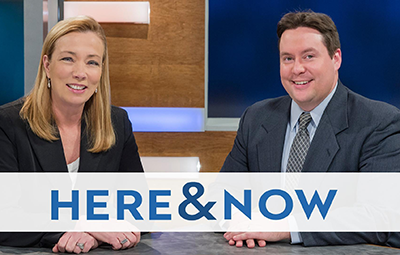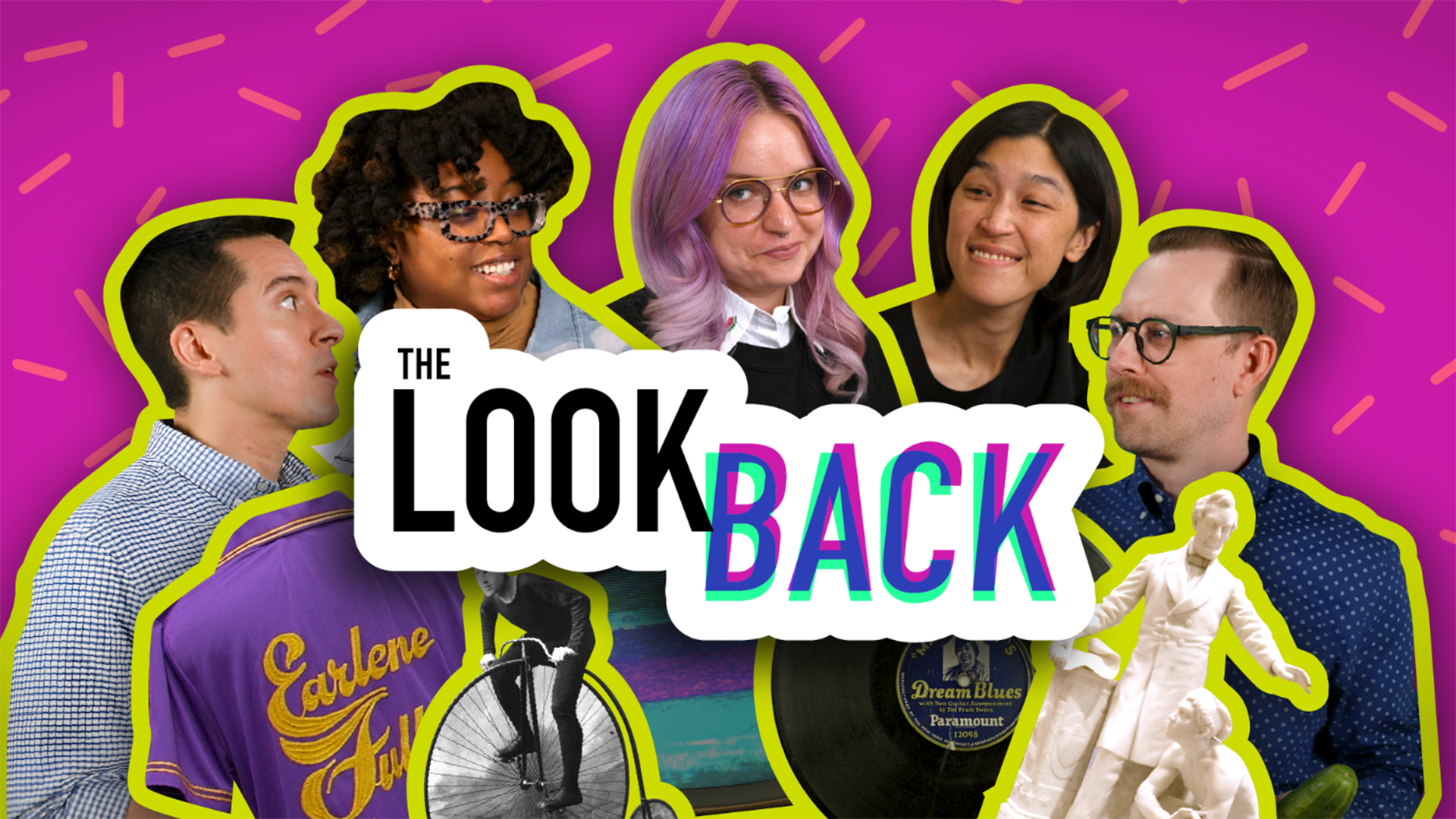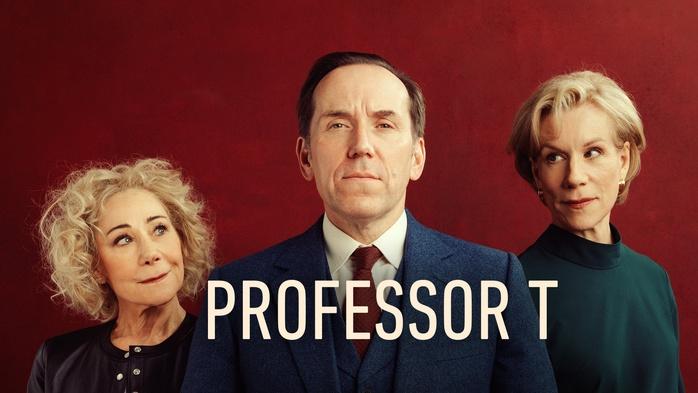Announcer:
The following program is a PBS Wisconsin original production.
Tony Evers:
Hey Wisconsin, Governor Tony Evers here.
Frederica Freyberg:
In Wisconsin, an incumbent calls it quits for the next round, leaving a long list of governor wannabes on both sides. While in Washington, summer recess starts early.
I’m Frederica Freyberg. Tonight on “Here & Now,” a wide-open race for Wisconsin governor. Republican U.S. Representative Bryan Steil on federal budgets. We continue our series “Rx Uncovered,” looking at pharmacy decline and an old bridge in western Wisconsin will soon be closed and replaced. How many other bridges in the state need work? It’s “Here & Now” for July 25.
Announcer:
Funding for “Here & Now” is provided by the Focus Fund for Journalism and Friends of PBS Wisconsin.
Frederica Freyberg:
Big news in state politics. Wisconsin Governor Tony Evers announced this week he will not run for reelection to a third term. His announcement means Wisconsin will see the first open race for governor in 16 years. A crowded field of Democrats are expected to vie in a primary next August. Likewise, several Republicans have either declared or expressed interest in running for governor. The election is November 3rd, 2026.
Head spinning feints and fights in Washington this week, and the Republican House Speaker cut short the legislative session as some congressional members demanded votes on releasing the Jeffrey Epstein files. Our next guest was among those who got an early recess. Wisconsin 1st District Republican U.S. Representative Bryan Steil joins us and thanks very much for being here.
Bryan Steil:
Thanks for having me on.
Frederica Freyberg:
So first off, what is your reaction to Tony Evers not running for a third term?
Bryan Steil:
I think what you’re going to see is a large number of Democrats get in the race and run to the left, but what we have to do is get our state back on track. Not measuring things like education by just how much money we’re spending, but on how well we’re doing. Whether or not students are being taught how to learn, not what to know. Whether or not we’re getting the spending in Wisconsin under control and money back to hard paying taxpayers. I think you’re going to have a robust debate. I think at the end of the day, we have a great opportunity to have a conservative governor once again.
Frederica Freyberg:
Do you have a favored candidate at this point?
Bryan Steil:
No, I’m not running. I’m going to be running for reelection to the House of Representatives. We’ll watch the Republican field play out. But I think we have a large number of great, strong candidates and one of them will ultimately be successful.
Frederica Freyberg:
So this week’s House session was cut short, as we said, by the speaker, attributed to what the Wall Street Journal called “furor over disclosures from the Epstein investigation.” What’s your reaction to the distraction that the whole Jeffrey Epstein file is causing?
Bryan Steil:
The broader media landscape loves to talk about Epstein. They don’t want to talk about the president’s success of securing the border, about the positive impacts of the tax package that was just passed. I think it’s a lot to do about nothing. I think I lean on the side of more disclosure is always a good thing. Sunlight is the best disinfectant. I think actually we should just move forward with this, disclose what’s legally permissible. It’s obviously under a court seal. It’s not under the direct control of Congress.
And then get really back and try to draw the attention of the media, who loves to be distracted by this, back to the most important issues of the day.
Frederica Freyberg:
Now, a new Marquette Law School national poll shows that 41% of respondents support the reconciliation bill that President Trump signed into law, while 59% oppose it, of course, with sharp, partisan divides. Why did you vote in favor?
Bryan Steil:
Look at the underlying provisions inside the bill. Let’s talk about what we got done. Almost every single thing is net popular once the American people understand what’s in the bill. This is about doubling down and making sure that the border is secure. Wildly popular. The president’s moves to do that and then building to make sure that’s permanent – a good thing. Investing in the military at a period of time of dangerous global instability. Making sure the 2017 tax cuts are permanent to build on the economic growth that we saw leading into the pandemic, and then doubling down on that, in particular for seniors, those working overtime or those who are earning tips. And then finally getting spending under control. And this is where the demagoguery has been probably the most challenging. Putting in place work requirements for able bodied, childless adults is an 80/20 issue in the state of Wisconsin, as indicated by the not-so-long-ago referendum. That’s what this bill does. It actually secures the program for those it was designed for: permanently disabled adults, children, pregnant women. And it simply says if you’re an able bodied, childless adult of working age, we’re asking you to be looking for work, volunteering or working a minimum of 20 hours a week. And so the provisions of the bill, as American people learn more and more about them, I think will only become more popular because they are common sense reforms to get this country back on track.
Frederica Freyberg:
So the Congressional Budget Office did estimate that this law will cut federal spending on Medicaid and CHIP benefits by $1 trillion, due in part, the CBO says, to at least 10.5 million being eliminated from the program.
Bryan Steil:
But let’s dive into those numbers, right, because the people are using those numbers to try to scare people in the state of Wisconsin. Wisconsin has had work requirements for many of our welfare programs, in particular SNAP benefits since the 1990s when Governor Tommy Thompson put them in place. In Medicaid, we don’t have the exact work requirements that the federal government has or that this law passes. What this law does is simply say, if you’re an able bodied, childless adult, we want you to be looking for work, going to school, volunteering, or working 20 hours a week. This is an 80/20 common sense issue. If you say — if you dig further into that, who is the CBO examining? I’m of the positive view that as those people find themselves — find themselves with an opportunity to get a job, to volunteer, that we won’t see folks losing their, their health benefits. What we’ll see is people getting into a good or a better paying job with the ultimate goal of many of these able bodied, childless adults getting into the workforce and receiving their health care from their employer like many hardworking, hardworking families in the state of Wisconsin do.
Frederica Freyberg:
What about changes to the Affordable Care Act that I understand, and according to Congresswoman Moore, will raise premiums and also impose other restrictions, restrictions potentially causing people to lose their coverage?
Bryan Steil:
Give me, give me the details on that. I think what, what you’re taking there is national analysis on the state of Wisconsin that doesn’t apply. Wisconsin didn’t expand Medicaid. And so some of the reforms are made in other states apply differently. This is what is really dangerous about the demagoguery that some individuals want to engage in. They want to take a national narrative and apply it to Wisconsin. Wisconsin, I think very thoughtfully, did not expand Medicaid further into the able-bodied, childless working age population. And so, again, of the 1.2 million individuals in the state of Wisconsin who currently are on Medicaid, Tony Evers appointee noted that there’s about 163,000 of them that are of the demographic that we should look at: able bodied, childless adults. Well over half of those are already working 20 hours a week, going to school, volunteering, 63,000 are not or are not documenting it. And so this is about making sure that we’re strengthening the program for those that it’s designed for – no changes and in fact, in my opinion, strengthening. Wisconsin after the passage of the state budget will actually receive about $1 billion a year more in federal money. We can have a whole debate about that, but more money is coming in. And so the left is trying really hard to demagogue on this issue. As the facts got out, you saw a quick pivot into Epstein, which was the lead question of your interview. So what we need to do is to dive in, get the information out to the American people about how we’re strengthening the program. And I think as the American people learn more and more about this, it’s only going to be more popular. Again, the work requirements in the state of Wisconsin had a referendum: 80/20, popular.
Frederica Freyberg:
As to the recent rescissions package that stripped appropriation funding from USAID and the Corporation for Public Broadcasting, do you expect and support additional rescissions as a way to cut costs going forward?
Bryan Steil:
Washington has a massive spending problem. We’re spending almost $2 trillion a year more than we’re taking in and the debt is well over $30 trillion. I think we need to go through the federal budget with a fine-tooth comb to remove waste, fraud and abuse. Look at programs that could find either other sources of funding or aren’t necessary. And so I think it’s appropriate to make sure that we’re combing through the federal budget, looking for ways to save taxpayer dollars. And again, in a period of time where every extra dollar we spend is effectively a dollar borrowed from China, I think it’s absolutely appropriate to dig through the federal budget and look for ways to save funds for hard working families.
Frederica Freyberg:
U.S. Representative Bryan Steil, thanks very much.
Bryan Steil:
Thank you.
Frederica Freyberg:
On health care, we continue our coverage of prescription drug prices, which continue to climb for patients and pharmacies, while coverage of them continues to plummet. In “Rx Uncovered,” “Here & Now” producer Marisa Wojcik examines the complex systems driving these trends. This week, we look at the impact on pharmacies, both big and especially small, and why their disappearance is hurting patients.
Nicole Schreiner:
We have been in business for over 70 years.
Marisa Wojcik:
The local drugstore was once upon a time a staple in communities across the country.
Nicole Schreiner:
We look at our financials every month and it’s scary, and we think about how, how long can we last?
Marisa Wojcik:
Today, whether it’s the local drugstore or a chain pharmacy, the brick-and-mortar presence is dying.
Nicole Schreiner:
The feasibility of having an independent pharmacy is becoming very challenging.
Marisa Wojcik:
Nicole Schreiner is the new CEO of Streu’s Pharmacy in Green Bay and president-elect on the board of the Pharmacy Society of Wisconsin.
Nicole Schreiner:
We get up in the morning because we want to truly help serve our patients.
Marisa Wojcik:
Alongside her commitment to the mission, she takes on her new dual roles in one of the most challenging times for pharmacies. From 2010 to 2021, 30% of drugstores in the U.S. closed. Last year alone, 2300 pharmacies closed, half of them being independent or mid-sized businesses.
Nicole Schreiner:
It’s creating an access issue for patients. We oftentimes talk about in rural areas, you know, patients having to travel, you know, perhaps 20 miles to find a pharmacy that would be able to provide their medications. And — but we’re having that even in urban city areas.
Marisa Wojcik:
For some, a visit to the pharmacy is a quick stop, picking up one or two prescriptions. But for many patients, it’s much more than that.
Mary Felzkowski:
Your pharmacist, a lot of times, will be a critical component of your medical care team.
Marisa Wojcik:
Senate President Mary Felzkowski authored legislation trying to help local pharmacies keep their doors open.
Mary Felzkowski:
We saw our small, independent pharmacies starting to go out of business in rural Wisconsin.
Marisa Wojcik:
When it may take months for a patient to get a clinic visit. Pharmacists say they bridge that gap, available for anyone to walk in and ask questions at any time and prevention leads to healthcare savings.
Nicole Schreiner:
For patients with asthma, we did a study with the Pharmacy Society of Wisconsin and showed that when they sat down with a pharmacist on two 30-minute interventions, that they reduced the number of ER visits, the number of hospitalizations. These things are making a difference in overall reducing health care dollars spent.
Marisa Wojcik:
Like with most retail stores, it’d be reasonable to assume that internet sales are putting pharmacies out of business. And while mail order and online retailer giants like Amazon do compete with onsite service, advocates diagnose a much deeper and chronic issue.
Mary Felzkowski:
PBMs – pharmacy benefit managers – have been around for a very long time.
Marisa Wojcik:
Pharmacy benefit managers or PBMs act as middlemen between drug manufacturers, wholesalers, providers, insurance companies and pharmacies.
Mary Felzkowski:
And they’ve monopolized and they’ve gotten in between prescribers and the delivery of drugs, driving up the cost of drugs instead of lowering them.
Marisa Wojcik:
The three largest PBM companies accounted for 80% of prescription claims last year.
Ben Pearlman:
They’ll claim that they negotiate with drug manufacturers and pharmacies to reduce overall prescription drug costs. However, despite these claims, PBMs regularly inflate what patients pay and force pharmacies to operate at a loss.
Nicole Schreiner:
It’s become very powerful, and independent pharmacies like myself have no negotiating power anymore with these PBMs.
Bob Jaskolski:
The impact of PBMs, that PBMs are having on rural pharmacies, is staggering.
Marisa Wojcik:
The legislation takes aim at a number of their practices, including not allowing patients to fill prescriptions at certain pharmacies.
Bob Jaskolski:
PBMs dictate where prescriptions can be filled…
Marisa Wojcik:
Punitive audits against pharmacists who inform patients of lower cost options.
Bob Jaskolski:
…what to charge a patient…
Marisa Wojcik:
And perhaps the biggest of all for pharmacies…
Bob Jaskolski:
…what they will reimburse a pharmacy…
Marisa Wojcik:
reimbursing the price of medications below cost
Bob Jaskolski:
…and when they’ll pay the pharmacy.
Marisa Wojcik:
forcing them to take losses. At a Senate health committee hearing, numerous local pharmacies attested to this issue.
Nic Smith:
My pharmacy is currently operating in the red right now, solely due to PBM reimbursement rate.
Larry Crowley:
Margins estimated to PBMs have increased by 46%, and during the same time, margins to pharmacies have decreased by 47%.
Nicole Schreiner:
The contracts have become basically take it or leave it. They’ve continued to erode year after year after year, and it’s estimated that independent pharmacies, depending on your particular location in the country, can have anywhere from 20 to 40% of their claims are actually reimbursed below cost.
Marisa Wojcik:
But not all health industry experts agree.
Abbey Rude:
We believe all these provisions will be associated with increased costs to health plans and sponsors.
Marisa Wojcik:
Those in opposition to the bill, such as health insurers, say it will increase prices for health plans, employers and patients. The exorbitant cost of drugs, they say, begins with the drug manufacturers.
Patrick Lobejko:
Instead of taking away the few tools that health plans and employers use to address ever increasing drug prices, the legislature should focus on fixing the market distortion caused by drug manufacturer pricing schemes.
Mary Felzkowski:
We’re going to work very hard on showing them through data from other states that have allowed that, that have the same legislation, where it’s actually lowered the cost of health care.
Marisa Wojcik:
Whatever the cause, the impact on the patient is real, like the ability to obtain diabetes medications.
Nicole Schreiner:
GLP-1s those — some pharmacies are just choosing not to carry them because they get reimbursed below their cost.
Marisa Wojcik:
Or having your insurance accepted.
Nicole Schreiner:
Some pharmacies are choosing not to carry particular plans because of the poor reimbursement.
Larry Crowley:
Every day in my pharmacy, I witness patients facing exorbitant co-pays, sometimes exceeding $500 for medications they cannot afford. These patients are confused. They’re overwhelmed, and they’re forced into impossible decisions about their health.
Marisa Wojcik:
For a patient having to fill prescriptions at multiple pharmacies, the consequences can cost them their lives.
Josie French:
Recently, when interviewing a patient, we learned that they had a duplicate prescription that was at another pharmacy from a different doctor. If they had gone home and taken both, they would have needed emergency care and it could have been fatal.
Marisa Wojcik:
From the extremes of the pandemic to the work they do every day, independent pharmacists say their commitment is to their community.
Nic Smith:
What happens if PBMs continue to drive us out of business? Who will step up during this crisis? Who’s going to be doing seven day a week testing? Who’s going to deliver meds late at night for a hospice patient? Who’s going to get a call at 2 a.m.? I just got that last week. It won’t be a mail order pharmacy in another state that’s doing that.
Nicole Schreiner:
Being able to provide that service to patients and to be part of making sure that they are taken care of, is really what we want to ultimately do.
Marisa Wojcik:
Reporting from Green Bay, I’m Marisa Wojcik for “Here & Now.”
Frederica Freyberg:
In other news, imagine you’re running late for work, but you have to take a water taxi or ferry over the river instead of driving over a bridge. That’s what will confront people in western Wisconsin when the bridge over the Mississippi River that connects De Soto to Lansing, Iowa, is removed this fall and replaced in 2027. As Erica Ayisi reports, the Lansing Bridge, also named the Black Hawk Bridge in Crawford County, has been under repair while still in use, but soon it will close altogether for replacement.
Erica Ayisi:
Closure, demolition and rebuilding are the new plans for the Black Hawk Bridge.
Timothy Gillespie:
The initial plan for the new bridge was that the old Black Hawk Bridge would remain open until the new bridge was completed.
Erica Ayisi:
But that Erica Ayisi plan has changed. The Village of De Soto President Timothy Gillespie says the announcement of the upcoming bridge demolition has residents worried about crossing the Mississippi River into Lansing, Iowa.
Timothy Gillespie:
Unfortunately, the Black Hawk Bridge will have to be closed in October, and so it’ll be about two years before the new bridge is ready.
Erica Ayisi:
The new bridge is being constructed along the existing bridge. According to the Iowa and Wisconsin Departments of Transportation, the east side of the existing bridge is posing a risk to the new bridge’s completion.
Timothy Gillespie:
And they said it’s becoming a safety issue. And they have to continue to drive the pilings down. And so it’s going to weaken, they think, the existing bridge and that’ll become a safety issue, a hazard.
Erica Ayisi:
The livelihood of local businesses on both sides of the river are at stake.
Timothy Gillespie:
There’s just going to have a very negative effect on a lot of businesses, not only in De Soto, but certainly in Lansing, Ferryville, Genoa, Harpers Ferry, New Albin, Iowa. All of those communities are going to be affected by this.
Erica Ayisi:
The bridge has been closed temporarily, briefly in the past. How were passengers impacted during those times?
Timothy Gillespie:
Well, they had a people ferry that they started and that was working pretty well. It, you know, it’s still pretty difficult for people to use a people ferry to, to get to work.
Erica Ayisi:
A people ferry and car ferry like this one could help business owners like Owen Buckmaster sustain his Lansing restaurant with Wisconsin customers.
Owen Buckmaster:
Just give them the option and more people would want to be involved and indulge in that car ferry, as opposed to just shuttling, busing and getting trucked across the river.
Erica Ayisi:
Transportation officials are exploring a car ferry service, but Gillespie says it will not meet the daily demand of cars crossing the bridge.
Timothy Gillespie:
They are only going to be able to bring 12, 14 cars at a time over, and that’s certainly not going to take the place of the traffic that was on the Black Hawk Bridge.
Erica Ayisi:
Justin Shepard of Shep’s Riverside Bar and Grill says customers need multiple crossing plans for businesses to stay afloat, especially through winter.
Justin Shepard:
As far as business goes, you know, they’ll run a shuttle hopefully until the ice comes through and then after the ice is in, you know, we don’t really know how that’s going to work because they don’t have a plan in place for that either.
Erica Ayisi:
Or a drive. The next closest bridge is U.S. Highway 18, connecting McGregor, Iowa, to Prairie du Chien, about 45 minutes away from the Lansing/De Soto bridge crossing.
Timothy Gillespie:
And there’s also a medical clinic over in Lansing. And so if we can’t get over there, then the people are going to have to go to Prairie du Chien or La Crosse, which is 30 miles in either direction.
Erica Ayisi:
Motorists will have to wait till 2027 to hear if the new bridge’s signature singing sound, wider width and indigenous name reference to Chief Black Hawk will remain the same. As Gillespie and other area village presidents seek government aid.
Timothy Gillespie:
Going to be looking for some kind of a federal or state aid to help support the loss of revenue that’s going to occur. So hopefully we can get some, some assistance.
Erica Ayisi
Reporting from De Soto, I’m Erica Ayisi for “Here & Now.”
Frederica Freyberg:
That bridge opened in 1931. How aged are other bridge crossings in Wisconsin? According to the National Bridge Inventory, of the more than 14,000 bridges in this state, nearly a thousand are classified as what they call “structurally deficient.” We turn to Wisconsin DOT Bureau of Structures Director Josh Dietsche for more. And thanks very much for being here.
Josh Dietsche:
Sure, not a problem. Happy to join.
Frederica Freyberg:
So what does it mean for a bridge to be “structurally deficient?”
Josh Dietsche:
So it’s a term that probably sounds a little scarier than it is. Really it just means that there is something, some kind of deterioration that’s been noted with the bridge. We always try to stress that that doesn’t mean it’s unsafe. If there’s a bridge open in the state, open to travel on, you can feel safe traveling across it.
Frederica Freyberg:
So does Wisconsin have a lot of older bridges, like the one like the Lansing Bridge?
Josh Dietsche:
Not many that are quite as old as the Lansing Bridge. The average age of the bridges that the state owns is about 37 years. The average age in the local system is about 42 years old. So yeah, something as old as the Lansing is a little bit atypical.
Frederica Freyberg:
In Wisconsin, what specific bridges need immediate repair or removal? Are there any?
Josh Dietsche:
Again, I would stress that if it’s open, it’s safe. So we always have a program where we’re going in and rehabilitating or replacing bridges. So you mentioned that there’s over 14,000 bridges in the state. About 2% of those are classified as being in poor condition. Kind of at a high level, we – as we inspect bridges, they get rated as either good, fair or poor. And so again, with about 2% of those bridges in poor condition, those are the ones that we’re focusing on. Again, not because they’re unsafe, not because you shouldn’t be traveling over them, but just because they’re going to need some work to keep them in service in the near future. So those are the ones that we’ve got in the program that are in the planning stages for, you know, again, getting some kind of rehabilitation or potentially being replaced.
Frederica Freyberg:
How heavy of a lift is it to inspect all of these more than 14,000 bridges across the state of Wisconsin?
Josh Dietsche:
Yeah, I think most people are surprised when we talk about it that we do have that many bridges in the state. You know about the big ones that you travel over but there’s so many that are over just small creeks or small rivers that you probably don’t even realize when you’re going over a bridge. So yeah, of those 14,000, about 5,000, a little over 5,000 are owned by the state, and the remainder then are owned by local municipalities, cities, villages, towns, and so on and so forth. So the state bridges are inspected by mostly by state forces, although we do use consultant engineers as well. And the same thing on the local side, the local side, they do have some local staff that will inspect bridges, but they lean heavily on consultant engineers as well. So when the bridges are in good condition, basically new, they can be inspected on as much as a four-year cycle. But for the most part, bridges are required to be inspected on a two-year cycle or as they get in that worst condition, into poor condition on an annual basis. So yeah, it’s a heavy lift depending on the size of the bridge. The larger bridges may take up to a week to inspect some of the larger bridges, like you referenced the Lansing Bridge or some of our more signature bridges. Others, you know, it can be done in a morning or an afternoon. But yes, it’s definitely a pretty big effort.
Frederica Freyberg:
We took a look at the work that’s happening on that bridge from De Soto to Lansing, and it made me wonder, how tricky is it to repair bridges while they’re still in use?
Josh Dietsche:
Yeah, it depends on the situation. You know, obviously the traffic is a big thing that plays into — that plays into that. You know, if you’re trying to repair a bridge on the interstate, there’s going to be lane closures. There’s a, there’s a large bridge over the Wisconsin River just north of Portage that’s being replaced right now. If you’ve driven through that area and in that case, you’ll see lane closures or lane shifts. So it’s definitely possible. But yeah, it does present some complications for sure. But again, we make — we make sure to do it in a way that is safe for sure. And as — we try to minimize the disruption to the traveling public as much as we can.
Frederica Freyberg:
All right. Well, we are all glad to know that the bridges are safe. John Dietsche, thank you so much.
Josh Dietsche:
No problem.
Frederica Freyberg:
For more on this and other issues facing Wisconsin, visit our website at PBSWisconsin.org and then click on the news tab. That’s our program for tonight. I’m Frederica Freyberg. Have a good weekend.
Announcer:
Funding for “Here & Now” is provided by the Focus Fund for Journalism and Friends of PBS Wisconsin.
Search Episodes

Donate to sign up. Activate and sign in to Passport. It's that easy to help PBS Wisconsin serve your community through media that educates, inspires, and entertains.
Make your membership gift today
Only for new users: Activate Passport using your code or email address
Already a member?
Look up my account
Need some help? Go to FAQ or visit PBS Passport Help
Need help accessing PBS Wisconsin anywhere?

Online Access | Platform & Device Access | Cable or Satellite Access | Over-The-Air Access
Visit Access Guide
Need help accessing PBS Wisconsin anywhere?

Visit Our
Live TV Access Guide
Online AccessPlatform & Device Access
Cable or Satellite Access
Over-The-Air Access
Visit Access Guide
 Passport
Passport






Follow Us